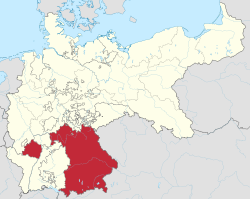Kingdom of Bavaria
Appearance
Kingdom of Bavaria Königreich Bayern Kenigreich Bayern | |||||||||||||
|---|---|---|---|---|---|---|---|---|---|---|---|---|---|
| 1805–1918 | |||||||||||||
| Anthem: Bayerische Königshymne | |||||||||||||
 The Kingdom of Bavaria (green) within the German Confederation (dark grey) in 1815 | |||||||||||||
 The Kingdom of Bavaria within the German Empire with the exclave of Palatinate | |||||||||||||
| Status | Electorate of the Holy Roman Empire (1805–1806) State of the Confederation of the Rhine (1806–13) State of the German Confederation (1815–66) Federal State of the German Empire (1871–1918) | ||||||||||||
| Capital | Munich | ||||||||||||
| Common languages | Bavarian, Upper German dialects | ||||||||||||
| Religion | Majority: Roman Catholic Minorities: | ||||||||||||
| Government | Constitutional Monarchy | ||||||||||||
| King | |||||||||||||
• 1805–1825 | Maximilian I Joseph | ||||||||||||
• 1825–1848 | Ludwig I | ||||||||||||
• 1848–1864 | Maximilian II | ||||||||||||
• 1864–1886 | Ludwig II | ||||||||||||
• 1886–1913 | Otto | ||||||||||||
• 1913–1918 | Ludwig III | ||||||||||||
| Prince Regent | |||||||||||||
• 1886–1912 | Leopold Charles | ||||||||||||
• 1912–1913 | Ludwig Leopold | ||||||||||||
| Minister-President | |||||||||||||
• 1806–1817 | Maximilian von Montgelas | ||||||||||||
• 1912–1917 | Georg von Hertling | ||||||||||||
• 1917–1918 | Otto Ritter von Dandl | ||||||||||||
| Legislature | Landtag | ||||||||||||
• Upper Chamber | Kammer der Reichsräte | ||||||||||||
• Lower Chamber | Kammer der Abgeordneten | ||||||||||||
| Historical era | Napoleonic Wars / World War I | ||||||||||||
| 26 December 1805 | |||||||||||||
• Established | 26 December 1805 | ||||||||||||
| 8 October 1813 | |||||||||||||
| 30 May 1814 | |||||||||||||
| 18 January 1871 | |||||||||||||
| 9 November 1918 | |||||||||||||
| 12 November 1918 | |||||||||||||
| Area | |||||||||||||
| 1910 | 75,865 km2 (29,292 sq mi) | ||||||||||||
| Population | |||||||||||||
• 1910 | 6,524,372 | ||||||||||||
| Currency | Bavarian gulden, (1806–1873) German gold mark, (1873–1914) German Papiermark (1914–1918) | ||||||||||||
| |||||||||||||
The Kingdom of Bavaria (German: Königreich Bayern; Bavarian: Kenigreich Bayern) was a historic German state that existed from 1805–1918. It became the Free State of Bavaria in 1918 and today since 1945 it is now called Bavaria.
Categories:
- 1800s establishments in Germany
- 1806 establishments in Europe
- 1918 disestablishments in Germany
- States of the German Empire
- States of the German Confederation
- States of the Confederation of the Rhine
- History of Bavaria
- States and territories established in the 20th century
- States and territories disestablished in the 20th century

